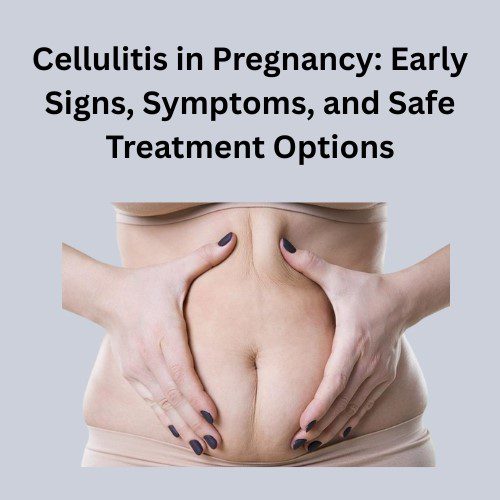Pregnancy is one of the most delicate and transformative phases in a woman’s life. While the body undergoes numerous physiological changes to nurture and protect the growing baby, it can also become more vulnerable to certain infections. One such condition that deserves special attention is cellulitis—a potentially serious bacterial skin infection. When it occurs during pregnancy, it requires prompt recognition and safe, effective management to protect both the mother and the unborn child.
Everything you need to know about cellulitis in pregnancy—including its early signs, symptoms, causes, prevention, and safe treatment options that ensure the well-being of both mom and baby.
What Is Cellulitis?
Cellulitis is a common bacterial infection that affects the deeper layers of the skin (dermis and subcutaneous tissue). It usually starts as a small area of redness, swelling, or tenderness and can rapidly spread if left untreated. The condition is most often caused by Streptococcus pyogenes (Group A Streptococcus) and Staphylococcus aureus, including Methicillin-resistant Staphylococcus aureus (MRSA) in some cases.
While cellulitis can affect anyone, pregnant women are at a slightly higher risk due to immune system alterations, fluid retention, and hormonal changes that make the skin more prone to breaks and infections.

Why Pregnant Women Are at Higher Risk
During pregnancy, the body experiences numerous immune, hormonal, and circulatory changes that can influence skin health and infection resistance. Here are some reasons why cellulitis may develop more easily in expectant mothers:
- Weakened Immune Response:
Pregnancy naturally suppresses parts of the immune system to protect the growing fetus, which can make it harder for the body to fight off infections. - Swelling and Edema:
Fluid accumulation in the legs and feet—common in pregnancy—can stretch the skin, making it more susceptible to small cracks and bacterial entry. - Hormonal Skin Changes:
Increased progesterone levels can cause skin sensitivity and minor irritations, providing entry points for bacteria. - Gestational Diabetes:
Women with gestational diabetes are more prone to skin infections, including cellulitis. - Reduced Mobility:
Late pregnancy often brings reduced movement, which can cause poor circulation and an increased risk of leg swelling and infections.
Common Areas Affected by Cellulitis During Pregnancy
Cellulitis can appear anywhere on the body, but during pregnancy, it most frequently affects areas that experience swelling, pressure, or trauma:
- Lower legs and ankles (most common)
- Feet (especially if swollen or cracked)
- Arms or hands (especially after insect bites or scratches)
- Abdomen or buttocks (particularly after minor skin injuries or medical procedures)
- Breasts (especially in late pregnancy or early postpartum period due to mastitis)
Early Signs and Symptoms of Cellulitis in Pregnancy
Recognizing the early warning signs of cellulitis is crucial for preventing complications. Pregnant women should be extra cautious and seek medical attention promptly if any of these symptoms appear.
1. Redness and Warmth
The infected area becomes red, warm to the touch, and often expands quickly. The redness usually has indistinct edges.
2. Swelling
Mild to severe swelling in the affected region is common, particularly around the ankles or legs, which are prone to fluid buildup during pregnancy.
3. Pain or Tenderness
The area may feel sore, tender, or painful, making it difficult to move or apply pressure.
4. Skin Tightness and Shiny Appearance
As the infection worsens, the skin may appear stretched, shiny, or tight due to swelling.
5. Fever and Chills
In more advanced cases, systemic symptoms like fever, chills, and fatigue may appear—signs that the infection is spreading.
6. Blistering or Pus Formation
If untreated, cellulitis can cause blisters or abscesses filled with pus, requiring urgent medical attention.
7. Enlarged Lymph Nodes
The lymph nodes near the infected area (such as in the groin or armpit) may become swollen or tender.
Potential Complications of Cellulitis in Pregnancy
If cellulitis is not treated promptly, it can lead to serious health risks for both the mother and baby. Some potential complications include:
- Sepsis (Blood Infection):
The bacteria can enter the bloodstream, leading to life-threatening systemic infection. - Abscess Formation:
Pockets of pus may develop, requiring drainage. - Lymphangitis:
Inflammation of lymphatic vessels may occur, causing red streaks along the skin. - Deep Tissue or Bone Infections (Osteomyelitis):
If bacteria spread deeper, bone infection may develop, complicating treatment. - Preterm Labor:
Severe infections may trigger early labor or cause pregnancy complications. - Increased Risk of Recurrence:
Once cellulitis occurs, future infections may be more likely, especially in areas with scar tissue or poor circulation.
Diagnosis: How Doctors Confirm Cellulitis During Pregnancy
Doctors usually diagnose cellulitis through clinical examination and medical history, but additional tests may be needed to confirm the infection or rule out other causes.
1. Physical Examination
A healthcare provider will examine the affected skin area, checking for redness, warmth, swelling, and tenderness.
2. Blood Tests
Blood work may be performed to assess infection markers, such as:
- Elevated white blood cell count (WBC)
- Increased C-reactive protein (CRP)
3. Wound Culture
If pus or fluid is present, a sample may be collected to identify the bacteria responsible and determine antibiotic sensitivity.
4. Imaging Tests
In severe or unclear cases, ultrasound or MRI may be used to detect abscesses or deeper infections.
Safe Treatment Options for Cellulitis During Pregnancy
Treating cellulitis during pregnancy must balance effective infection control with safety for the developing baby. The good news is that most cases can be managed safely with appropriate medical care.
1. Antibiotic Therapy
Antibiotics are the cornerstone of cellulitis treatment. Pregnant women should never self-medicate—only take antibiotics prescribed by a healthcare provider familiar with pregnancy-safe options.
Common pregnancy-safe antibiotics include:
- Penicillin (e.g., amoxicillin, dicloxacillin)
- Cephalosporins (e.g., cephalexin)
- Erythromycin (if allergic to penicillin)
- Clindamycin (for MRSA or penicillin allergy cases)
Avoid during pregnancy (unless specifically advised):
- Tetracyclines (can affect fetal bone/teeth development)
- Sulfa drugs (can cause neonatal jaundice)
- Fluoroquinolones (linked to cartilage development issues)
2. Rest and Elevation
Resting and elevating the affected area (especially the leg) can reduce swelling, improve circulation, and speed healing.
3. Hydration and Nutrition
Staying hydrated and maintaining a balanced diet rich in vitamin C, zinc, and protein supports immune function and skin repair.
4. Pain and Fever Management
Acetaminophen (paracetamol) is generally considered safe for reducing fever or discomfort during pregnancy. Always consult your doctor before taking any medication.
5. Warm Compresses
Applying gentle, warm compresses to the infected area may relieve pain and promote drainage—but avoid excessive heat or direct pressure.
6. Hospitalization for Severe Cases
If cellulitis spreads rapidly or is accompanied by high fever or systemic symptoms, hospitalization may be necessary for intravenous (IV) antibiotics and monitoring.
Home Care and Supportive Remedies
While medical treatment is essential, some home care measures can support recovery and prevent complications.
- Keep the Area Clean:
Gently wash with mild soap and water to prevent bacterial buildup. - Avoid Scratching or Tight Clothing:
Friction can worsen inflammation or spread infection. - Wear Compression Stockings (If Advised):
These may help reduce leg swelling and prevent recurrence, especially in later pregnancy. - Rest Frequently:
Adequate rest helps your immune system fight the infection effectively.
🌿 Cellulitis in Pregnancy: Safe Home Remedies for Relief
Cellulitis is a bacterial skin infection that causes redness, swelling, pain, and warmth in the affected area. During pregnancy, a woman’s immune system undergoes natural changes, making her more vulnerable to infections, including cellulitis. While medical treatment (especially antibiotics) is essential for recovery, some gentle home remedies can help reduce discomfort and speed up healing alongside doctor-approved treatments.
⚠️ Important: Never try to treat cellulitis at home without consulting a healthcare professional. Herbal Remedies for Cellulitis are only supportive measures, not substitutes for medical care.
🧴 1. Warm Compress for Swelling and Pain Relief
Applying a warm, moist compress to the infected area helps improve blood flow and reduce pain.
How to use:
- Soak a clean cloth in warm (not hot) water.
- Apply it to the affected area for 10–15 minutes, 3–4 times daily.
- Avoid excessive heat to prevent skin burns.
Benefits:
Reduces discomfort, promotes drainage of pus (if present), and speeds healing.
🧘♀️ 2. Elevate the Affected Limb
If cellulitis affects your leg or arm, elevate it above heart level.
Why it helps:
- Reduces swelling.
- Improves circulation.
- Prevents the spread of infection.
Tip:
Use pillows to raise your leg or arm while resting or sleeping.
💧 3. Stay Hydrated
Drinking plenty of water supports the immune system and helps your body fight infection.
Recommended:
- Drink at least 8–10 glasses of water daily.
- Include coconut water or fresh fruit juices (without added sugar) for hydration and essential nutrients.
🥦 4. Boost Immunity with a Nutrient-Rich Diet
A strong immune system helps your body combat cellulitis more effectively.
Pregnancy-safe foods include:
- Vitamin C-rich foods (oranges, kiwi, strawberries, bell peppers).
- Protein sources (lean meats, eggs, lentils).
- Zinc-rich foods (pumpkin seeds, chickpeas, nuts).
- Leafy greens (spinach, kale) for antioxidants and iron.
Avoid: Processed foods, sugary drinks, and excessive salt.
🧄 5. Natural Antibacterial Foods
Certain foods have antibacterial and anti-inflammatory properties that can help support recovery.
Safe options during pregnancy:
- Garlic: Natural antibacterial; add fresh garlic to meals.
- Turmeric: Anti-inflammatory; mix a small pinch in warm milk or use in cooking.
- Ginger: Boosts immunity; drink mild ginger tea or add to food.
Avoid high doses of these herbs without medical approval, as some may affect pregnancy if overused.
🌸 6. Gentle Skin Care and Hygiene
Good hygiene is crucial to prevent worsening infection.
Tips:
- Wash the affected area gently with mild soap and warm water.
- Pat dry—avoid rubbing.
- Keep the area clean and covered with a sterile bandage.
- Change bandages daily or as advised by your doctor.
🩴 7. Avoid Tight Clothing and Footwear
If cellulitis occurs on your leg or foot, tight clothing or shoes can restrict blood flow.
Choose:
- Loose, breathable cotton clothing.
- Comfortable maternity footwear that allows circulation.
🌻 8. Rest and Elevation
Your body heals best when you rest. Fatigue during pregnancy is already common, so extra rest helps your body focus on fighting infection.
Tip:
Lie down with the affected limb elevated for 30 minutes several times a day.
☕ 9. Use Herbal Compresses (Only if Doctor Approves)
Some mild herbal compresses can soothe inflammation and pain.
Safe herbs (use externally only):
- Chamomile tea compress: Soothes swelling and irritation.
- Calendula infusion: Natural antibacterial properties.
How to use:
Dip a clean cloth in the cooled herbal tea, apply gently for 10 minutes, and pat dry.
🩹 10. Moisturize Gently
Dry or cracked skin can worsen infection. Use pregnancy-safe, fragrance-free moisturizers to keep the area soft and protected.
Recommended:
- Aloe vera gel (pure and natural).
- Coconut oil (light layer to prevent dryness).
Prevention: How to Avoid Cellulitis During Pregnancy
Prevention is always better than cure—especially during pregnancy, when treatment choices are limited. Here are some essential tips to minimize your risk:
1. Practice Good Skin Hygiene
Regularly clean your skin, especially the feet and legs, and moisturize to prevent dryness and cracking.
2. Manage Swelling and Edema
Elevate your legs when resting, avoid standing for long periods, and wear maternity support stockings if recommended.
3. Treat Minor Skin Injuries Promptly
Clean small cuts, insect bites, or scratches immediately and cover them with sterile bandages.
4. Control Blood Sugar Levels
If you have gestational diabetes, maintaining healthy glucose levels can significantly lower infection risk.
5. Wear Comfortable Footwear
Properly fitting shoes reduce friction and prevent blisters that can serve as entry points for bacteria.
6. Avoid Sharing Personal Items
Towels, razors, and nail tools can spread bacteria—keep them personal and clean.
When to Seek Medical Attention
Pregnant women should contact their healthcare provider immediately if they notice:
- Rapidly spreading redness or swelling
- Fever or chills
- Painful, warm, or tender skin
- Blisters or oozing pus
- Feeling generally unwell or weak
Prompt treatment can prevent complications and ensure both maternal and fetal safety.
Prognosis: What to Expect After Treatment
With early diagnosis and proper treatment, most pregnant women recover from cellulitis within 7–10 days. Severe cases may take longer but typically respond well to antibiotics and supportive care. Recurrence is possible, especially in those with chronic leg swelling or varicose veins, so prevention and skin care remain vital even after recovery.
Frequently Asked Questions (FAQs)
1. Can cellulitis harm my baby?
If treated promptly, cellulitis does not usually harm the baby. However, untreated infections can cause systemic illness that might affect pregnancy health.
2. Can I breastfeed if I develop cellulitis postpartum?
Yes, in most cases. However, if cellulitis occurs near the breast (mastitis), your doctor will guide you on safe breastfeeding practices and antibiotic use.
3. Can cellulitis come back after pregnancy?
Yes, recurrence can occur, especially if underlying issues like leg swelling or diabetes persist. Preventive care is key.
4. Is cellulitis contagious?
Cellulitis itself is not contagious, but the bacteria causing it (like Staphylococcus aureus) can spread through direct contact or shared items.
Conclusion
Cellulitis in pregnancy may sound alarming, but with early recognition, safe Natural Treatment for Cellulitis, and proper care, it can be effectively managed without endangering the mother or the baby. Understanding the early signs—such as redness, warmth, and swelling—and seeking medical help immediately can prevent complications and promote a healthy pregnancy journey.
Maintaining good hygiene, proper skin care, and balanced nutrition plays a crucial role in both prevention and recovery. Always follow your doctor’s advice, take prescribed antibiotics as directed, and monitor your symptoms closely.
Pregnancy is a time to nurture both body and soul—and ensuring your skin stays healthy is a vital part of that journey. By staying alert and proactive, you can protect yourself and your baby from the risks of cellulitis and enjoy a safe, healthy pregnancy.




